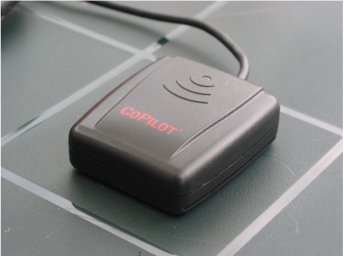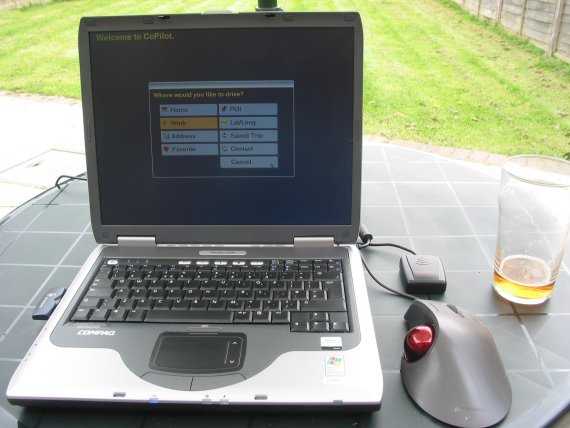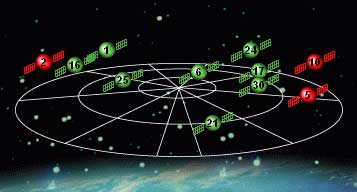 Review by Dave Burrows Review by Dave Burrows
CoPilot comes in a number of different bundles, whether you want a Compact Flash GPS Receiver, a Serial GPS Receiver, a USB GPS Receiver or even a Bluetooth GPS Receiver. This review is based upon the USB GPS Receiver.
The CoPilot USB GPS is based around the Rikaline GPS-6010, it differs in the fact that it doesn't have a PS/2 style connector, it comes supplied in a USB connector for connecting to a USB enabled Laptop, Notebook or Tablet PC and is rebranded CoPilot.
The CoPilot USB GPS Receiver comes bundled with CoPilot Laptop 7 (a review is available here of the software).
In The Box
When you open up the box you will find:-
- DVD style box with 2xCoPilot CD's for Western Europe
- USB (or Serial) GPS Receiver
 
Installation Once you have installed CoPilot Laptop 7 all the correct USB drivers will be installed for the USB GPS Receiver, so all you then need to do is plug the GPS Receiver into a spare USB port and the light on the top of the GPS Receiver should start to blink. Installation really is as simple as that!

Technical Specification
| Performance |
|
| GPS Signal |
L1, C/A Code |
| Channel |
12 Channels |
| Tracking Sensitivity |
-142dBm |
| WAAS |
Yes |
| DGPS |
Yes |
| |
|
| Acquisition Time |
|
| Re-Acquisition |
0.1 Seconds |
| Hot Fix |
8 Seconds |
| Warm Fix |
38 Seconds |
| Cold Fix |
45 Seconds |
| |
|
| Standard Accuracy |
|
| Position |
25m (95%) CEP |
| Velocity |
0.1 m/sec |
| Acceleration |
<4g |
| |
|
| WAAS Accuracy |
|
| Position |
1-5m (95%) CEP |
| Velocity |
0.05 m/s |
| Acceleration |
<4g |
| |
|
| Dynamic Conditions |
|
| Altitude |
18,000 meters |
| Velocity |
515m/sec |
| Acceleration |
4G Max |
| |
|
| Physical Dimensions |
|
| Width |
59.3mm (2.33") |
| Depth |
50.2mm (1.98") |
| Height |
19.7mm (0.78") |
| Weight |
103g |
| |
|
| Power |
|
| Input |
4.75 to 5.5v DC |
| Internal Backup |
3.3V (1000 hours) |
| |
|
| Environmental |
|
| Operating Temperature |
-40 to +85C |
| Storage Temperature |
-55 to +100C |
| |
|
The GPS Receiver in use
I have used the receiver now for over a month in a variety of conditions from light foliage to normal day use. In all cases I found the receive quite sensitive to difficult conditions like foliage and canyon environments, in terms of signal, and with no 'Lag' associated with some of these higher sensitivity GPS receivers can have depending on the strength of the signal it's receiving.
 Most days I saw an average of 8-9 satellites where you would usually expect to see 7-9 on an average day. Most days I saw an average of 8-9 satellites where you would usually expect to see 7-9 on an average day.
The GPS Receiver came configured to run at NMEA 4800 baud which is the standard for most GPS Receivers as 4800 baud is more than enough speed to allow the signal to come in and transferred to the PC without dropping data.
The image to the right is the satellite display taken from WinFast Navigator for the PC. It shows that the receiver knows about 11 satellites and has got a fix on 8. Click the satellite image to the right to see a full screen version.
 Connecting using a Diagnostics Program Connecting using a Diagnostics Program
If you download WinFast Navigator which is available in our Downloads page under the Leadtek Drivers & Software section. Make sure you download and install the PC version. Then run the Navigator icon, click the CONNECT button specify the COM port your CoPilot GPS is on and NMEA 4800 and click OK and you should see data flying past in the top right hand window pane (Development Data View) and after a short while you should start to see bars appearing in the pane below this (Signal View).
Price and Availability
At the time of writing this review, CoPilot Laptop 7 was available for £299 including USB GPS Receiver. GPS Receiver cannot be purchased separately but you can purchase the Rikaline GPS which is very similar to the CoPilot GPS.
Conclusion
The CoPilot USB GPS Receiver worked well both in the test lab and also out in the open. In the test lab where I will usually see around 4 signals inside in my office, I was receiving 6 from the CoPilot USB GPS Receiver. Likewise out on the road, the GPS was very quick at obtaining a fix, no hanging around and once acquired it kept the fix without any need for re-acquisition.
|